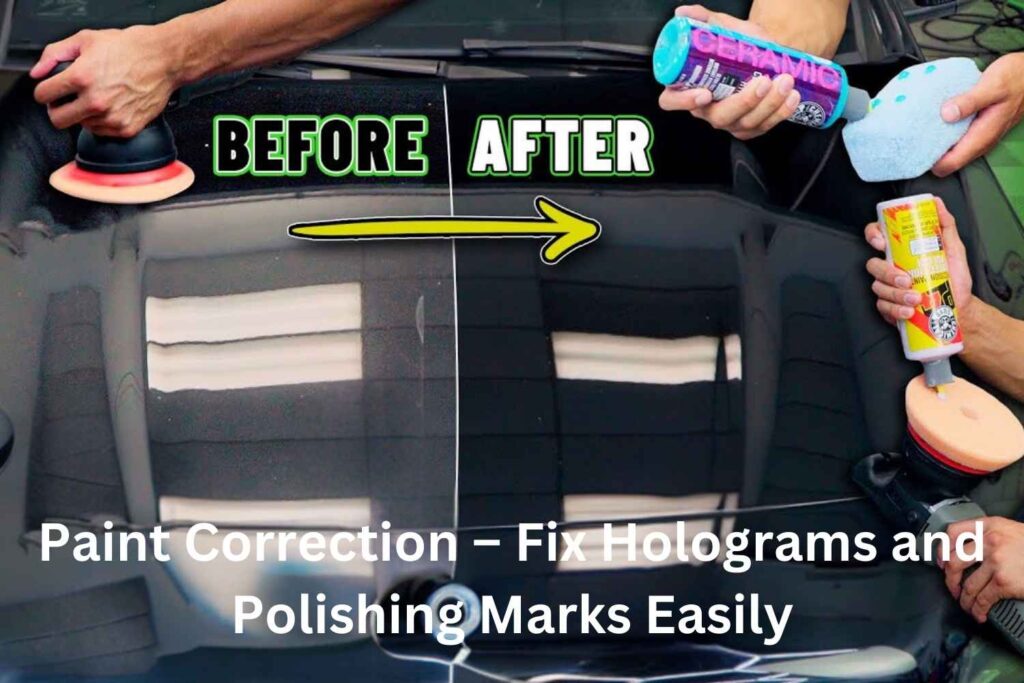Have you ever parked under a shady tree, only to return and find sticky, dried sap glued to your car’s surface? At first glance, it might seem like a minor inconvenience, but removing sap is more than just wiping it away. When it dries, sap hardens and clings to your car’s paint, making it tricky to remove without causing damage. So, how can you safely get rid of this stubborn residue without leaving scratches or dulling the paint? In this guide, we’ll explore effective, easy-to-follow methods that protect your car’s finish while removing the sap. Read on to discover the best ways to restore your car’s shine without harming its paint. Ready to give your car a fresh look again? Let’s dive in!
Table of Contents
ToggleUnderstanding Why Tree Sap is Harmful to Car Paint
Tree sap, though natural, has a sticky and acidic makeup. When it lands on your car, it starts bonding with the paint almost immediately. Over time, especially when exposed to sunlight, the sap hardens and can etch into the paint. This can lead to rough spots and even discoloration. Imagine leaving gum stuck on a shiny new surface—tree sap is similar, just harder to remove!
Leaving sap on your car for too long can make it so difficult to remove that it might even require professional help. But luckily, if you act soon and follow these methods, you can handle it yourself!
Preparing Your Car for Safe Sap Removal
Before jumping into sap removal, it’s best to prepare the car to avoid any scratches or damage. Here’s how:
- Park in a Shaded Spot: Sunlight can bake the sap onto your car, making it harder to remove. Parking in the shade keeps the surface cool and prevents further hardening.
- Wash the Area: Take a bucket of warm water and add car wash soap. Gently clean the area where sap has fallen, removing any dirt or dust that could scratch the paint during sap removal. Use a microfiber towel, as it’s soft and won’t harm the paint.
- Test on a Small Area: If you’re planning to use a sap remover or alcohol, test it on a hidden area first. This will ensure that the product doesn’t react badly with your car’s paint.
Methods for Removing Fresh Tree Sap
When tree sap is freshly fallen, it’s usually softer and easier to handle. Here are a couple of gentle methods to try first:
1. Warm Soapy Water Method
- Step 1: Mix warm water with a small amount of car wash soap in a bucket.
- Step 2: Dip a microfiber cloth in the soapy water, wring it out, and gently rub the sap spot. Don’t press too hard; let the warm, soapy cloth loosen the sap naturally.
- Step 3: Check if the sap is lifting off. If it seems to be softening, continue gently rubbing.
- Step 4: Rinse the area with clean water and dry it with a fresh microfiber towel.
This method works best on fresh sap that hasn’t dried completely. Sometimes, a simple cleaning with warm soapy water is all it takes to lift it off!
2. Rubbing Alcohol or Hand Sanitizer
Rubbing alcohol is another great option, as it breaks down sap quickly and is safe for car paint if used carefully.
- Step 1: Pour a bit of rubbing alcohol onto a clean microfiber cloth or cotton ball.
- Step 2: Hold the cloth against the sap spot for about 30 seconds to allow the alcohol to soften the sap.
- Step 3: Gently rub in small circles. The alcohol will start breaking down the sap’s sticky properties, helping it lift away.
- Step 4: Rinse the area with water to remove any remaining alcohol, then dry it with a microfiber towel.
If you don’t have rubbing alcohol, a hand sanitizer with a high alcohol content can work as a substitute. Just remember to rinse the area well afterward to prevent any residue from staying on the paint.
Methods for Removing Hardened Tree Sap
When tree sap has been on your car for a while, it hardens and bonds with the paint, making it much trickier to remove. But don’t worry—you can still get rid of it without causing any damage. Here are some effective ways to handle it:
1. Clay Bar Treatment
Clay bars are a popular choice for removing tough residues like tree sap. They’re gentle on paint but work effectively to lift off sticky substances.
- Step 1: Start by washing and drying the sap-stained area with car wash soap and water. This removes any dirt that could scratch the paint.
- Step 2: Use a lubricant spray, like a quick detailer, and apply it generously to the area with sap.
- Step 3: Gently rub the clay bar over the sap spot in small, circular motions. The clay bar will “grab” the sap and pull it off the surface.
- Step 4: Wipe the area with a microfiber cloth to remove any residue, and rinse with clean water.
Tip: Be sure to knead the clay bar often to expose a fresh surface. This helps avoid scratching the paint as you work on multiple sap spots.
2. Olive Oil or WD-40 for Gentle Softening
Olive oil and WD-40 can help soften hard tree sap. They work well if you want to use something simple from home.
- Step 1: Apply a small amount of olive oil or spray WD-40 onto a microfiber cloth.
- Step 2: Dab the cloth onto the sap spot and let it sit for 1–2 minutes. This gives the oil time to soften the sap.
- Step 3: Once the sap is softened, gently rub it in a circular motion to remove it.
- Step 4: Wash the area with car wash soap and water to remove any oily residue, then dry it with a fresh microfiber cloth.
Olive oil and WD-40 work well for small, hardened sap spots. They won’t harm your car’s paint, but make sure to clean the area thoroughly afterward.
3. Using a Steamer
A steamer is an excellent tool for safely removing hardened sap by loosening it with gentle heat. This method minimizes the need for scrubbing, reducing the risk of paint damage.
- Step 1: Turn on your steamer and let it heat up. Once ready, hold it a few inches above the sap spot.
- Step 2: Slowly move the steamer over the sap for about 30 seconds to 1 minute, allowing the heat to soften it.
- Step 3: Once the sap has loosened, gently wipe it away with a microfiber cloth.
- Step 4: If needed, repeat until the sap is fully removed, then rinse the area with water and dry it.
Note: Be cautious with steam around windows or on colder days, as rapid temperature changes could cause cracking. Stick to moderate heat to keep the process safe.
Cleaning Up After Sap Removal
Once you’ve successfully removed the sap, it’s essential to clean up any leftover residues to keep your car’s paint in top condition. Here’s a simple follow-up routine to ensure your car looks as good as new:
- Rinse the Area: After removing the sap, rinse the treated area with clean water. This will remove any product residues like alcohol or oils that could attract dust if left behind.
- Rewash with Car Wash Soap: Use a fresh bucket of soapy water and a microfiber cloth to give the area a final clean. This step ensures all traces of sap remover or other materials are fully cleaned off, leaving your car’s paint smooth and residue-free.
- Dry with a Microfiber Cloth: Gently dry the area with a clean microfiber cloth to prevent water spots. This will also help you spot any remaining sap or sticky residue that might need additional attention.
- Polish or Wax: To restore your car’s shine, apply a layer of wax or polish. This improves how your paint looks and adds a layer that protects against sap, bird droppings, and other sticky stuff.
These steps help treated areas blend with the rest of your car. This leaves your car looking clean and protected.
Preventive Tips to Avoid Future Sap Damage
Now that your car is sap-free, let’s talk about a few ways to prevent this sticky issue from happening again. Here are some easy steps you can take to keep your car’s paint protected:
1. Choose Parking Spots Carefully
One of the simplest ways to avoid tree sap is by being mindful of where you park. Trees with a lot of holes in their trunks or broken branches tend to drip more sap. If possible, try to park in open areas or under shade structures rather than directly beneath trees.
2. Use a Car Cover
If you regularly park near trees, consider using a car cover. Covers are lightweight and easy to place over your vehicle. They protect against sap, bird droppings, and even dust, making them a worthwhile investment.
3. Regularly Wax Your Car
Applying a fresh coat of wax every few months provides a protective barrier on your car’s paint. Wax makes it harder for sticky substances like sap to bond with the paint. It also makes cleaning easier if sap does happen to land on your car.
4. Wash Your Car Often
Frequent washing helps prevent sap, pollen, or other contaminants from hardening on your car’s paint. The quicker you remove these substances, the less likely they are to damage the paint.
Conclusion: Keeping Your Car Paint Pristine
Removing tree sap takes a bit of time. But by using these safe and easy steps, you can keep your car looking nice and avoid paint damage. Always start with gentle methods and test products in small areas to be extra cautious. And, if you make a habit of protecting your car’s paint, you can save yourself the trouble of dealing with sticky sap in the future.
With these tips and tricks, you’ll be ready to handle any sap that comes your way. Enjoy the fresh, clean look of your car—and happy driving!
Frequently Asked Questions (FAQs)
How can I safely remove dried tree sap from my car’s paint without damaging it?
To remove dried tree sap safely, start with gentle methods. Try warm, soapy water and a microfiber cloth to see if the sap softens. If that doesn’t work, use a bit of rubbing alcohol or hand sanitizer on a cloth, hold it on the sap spot for a few seconds, then gently wipe it away. Be sure to rinse and dry the area afterward. For stubborn sap, a clay bar is a good option. Always test any product on a small, hidden spot to make sure it won’t harm your paint.
Can tree sap permanently damage my car’s paint if left untreated?
Yes, tree sap can damage car paint if it’s left on for too long. Sap hardens under sunlight and can bond with the paint, causing discoloration and rough spots. In some cases, it can even eat through the clear coat. The longer sap stays on your car, the more damage it can cause, so it’s best to clean it off as soon as possible to protect the paint.
What household products can remove tree sap from a car?
Household items like rubbing alcohol, hand sanitizer, and even olive oil can help remove tree sap. Dab a small amount of rubbing alcohol or hand sanitizer onto a cloth, then place it over the sap for a few seconds to loosen it. Gently rub the sap off. Olive oil can also soften sap; apply a bit on a cloth and wipe the area carefully. Afterward, rinse with soapy water to remove any residue.
How can I prevent tree sap from sticking to my car?
To avoid tree sap on your car, try parking away from trees whenever possible. Applying a good layer of car wax can also help create a barrier, making it harder for sap to stick to the paint. You can also consider using a car cover if you park under trees often, as it provides direct protection.
What should I do if I can’t remove all the sap on my own?
If sap spots remain after trying at-home methods, it’s best to get help from a professional detailer. They have special tools and safe products designed for stubborn sap removal. Professionals can often restore the paint to its original condition, which might be hard to achieve at home without the right equipment.
Disclaimer
The methods and products mentioned in this guide are for general informational purposes. While these techniques are widely recommended, always test any product or method on a small, hidden area of your car before full application to avoid potential paint damage. Some products, such as rubbing alcohol or WD-40, may affect car surfaces differently depending on paint type and finish. If you’re unsure or if the sap is especially tough, consult a professional auto detailer for assistance. Neither the author nor this guide can be held responsible for any damage resulting from the use of these suggestions. Always follow product instructions carefully.







